| Main |
Two Rooms and a Bath
|
Magyarul |
The first series of articulated trams appeared in Budapest only long after the war, in 1961, when the sitting-conductor service and the guided flow of passangers was introduced. The first such tram was the prototype articulated car, alias "Bengáli", which was built at the tramway company's own workshops. At this tramtype, only a long single-room tram was built, but there was not any kind of improvement introduced at the electrical equippment - the old two-motor direct regulation remained. Soon it was followed by the two-directional version, which was produced in great quantity until 1978, the latter series already in the workshops of Debrecen (east of Hungary). These trams are still in everyday use in the cities of Miskolc, Debrecen and Szeged. There was one more similar car in Budapest: the articulated UV, which existed between 1962 and 1966.
These articulated trams have the common point of the structure of the vehicle. The frontal and the rear section can stand on their four wheels by their own. However, the middle section is floating in between, it is hanged - or rather held in the air from below - on the two ends. The underframe of the front and the rear was lengthened under the articulation, and the middle section was leaning on these parts.
This solution is no local invention, already before the "Adél" there were several exemplars of trams with similar structure. This system was called "two-rooms-and-a-bath" type cars (or sometimes it was called "two rooms and a kitchen"). This page intends to explore the ancestors and followers of these articulated tramcars, with an interesting overview of the history of tram desingns from all over the world.
Today, looking back at the "Adél" it gives quite a mixed impression - the high-floor and the small windows resembling to the early look of the trams give a dissonant look with the long body and the "sort of streamlined" frontal construction. However, "Adél" is not alone with these anomalies in the international team. Naturally the mixing of the styles are because a tramcar produced in 1911 was converted into an articulated car at the time, when the streamlined forms were showing the technical advancement of the future. The later "Bengáli" shows a much more uniform style of the '50s, but it was constructed newly.
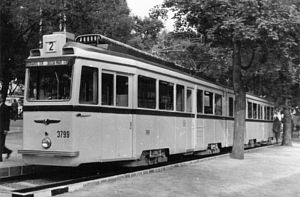 |
|
|
There is nothing surprising, that the invention of the "two-rooms-and-a-bath" trams comes from America. The first of its kind was running in Cleveland (Ohio). However, it is more spectecular, that the patent was registered in 1892, by the inventors named Brewer and Krehbiel. The local producer Kuhlman Car Company already made an experimental tram one year after, in 1893 for Cleveland.The first articulated trams in the United States
 Street Railway Journal/Modern Tramway
|
|
|
The articulated tram was far much ahead of the requests of the time, the costly conversion of the four-wheel trams to articulated ones was not worth the investment. In these years getting workscraft was easy, thus it meant no problem to organize the service with smaller tramcars. The need of building bigger, longer trams was appearing when there was already harder to recruit people. This era began in America during the first world war, and even in the time of the economic growth of the previous years. For this reason, another four-axle articulated prototype was constructed in Boston (Massachusetts) in 1912, which was followed by a series of similar cars. In the following years, there was ten trams constructed in Richmond (Virginia), then there was a prototype vehicle in Portland (Oregon) in 1914, and in Brooklyn (New York) in 1916. The greatest amount of such streetcars was still in use in Boston, where in the years 1915-17 another 110 articulated trams were built. This second series had already eight axles (similarly to the Portland prototype), as eight-wheel bogie trams were used for the reconstruction, which were more common in the US.
The trams were made only for a temporary use, since these cars were considered old-fashioned even at the time of the construction. They were only in service until they were replaced by newer types. The tram company of Boston was buying central-entrance trams from the '20s, which were often used in multiple sets for the next three decades, until the arrival of the PCC era. So the articulated cars of the US were often scrapped after a decade of usage.
Soon the three section tramcars appeared in the European countries, though before World War II in several cases only a prototype was constructed without a following series.Articulated tramcars in Europe
The first such reconstructions were in the scandinavian countries: in Göteborg (Sweden) a prototype was followed by a batch of ten cars in 1922-23. In Oslo (Norway), there was also a prototype tram constructed, which was introduced in 1924 to the general public.
The tramcars of Göteborg were assembled from ASEA-built trams made in 1908. These two-motored cars remained in service until 1949, their construction were far from being perfect, like their followers. The motorless axles was reportedly not very suitable to the hilly landscapes, the cars kept derailing. The Oslo car was similar type, in fact the middle section was made by the same company (Ljunggren), as for Göteborg. The two end were originally a motorcar made by Falkenried (1902) and Skabo (1906). After a few weeks of testruns, the articulated prototype was put aside, and finally in 1934 it was scrapped. This tram had actually a four-motor electrical equippment, however possibly the original controller was not able to regulate two times high current level. Because of the reorganization of the company in Oslo, there was no one to continue the experiment.
In Germany, two-rooms-and-a-bath articulated trams were built first in 1928-29: Dresden (made by Niesky/SSW, 1928) and Leipzig had each one prototype, and in Berlin there were two. Although, in other cities there were experiments with other articulated types (like in Duisburg, which had already in 1926 a six axle Jacobs-bogie tram), still it was not common to see in Germany articulated trams until the '50s.
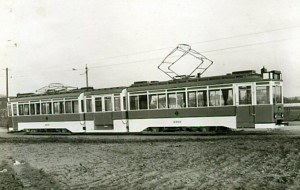 Collection Roy Budmiger
|
|
|
|
|
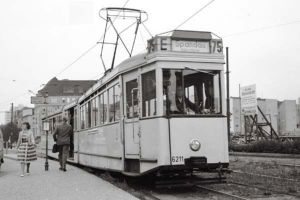 J.-B. Proudhommeaux/Amtuir
|
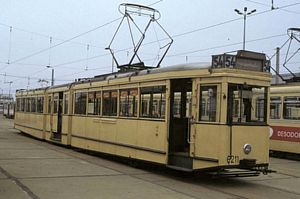 Roy Budmiger
|
|
|
|
It is interesting, that on the francolingual territory of Europe, where between the two wars still several cities had tram-service, there was only one place that held articulated cars in operation until the '60s (except a Jacobs-bogie articulated prototype from Marseille). This was not in mainland France, but in the colonial Alger. Here amongst the three tram-operators of the city, the Tramways Algériens ordered a prototype articulated tram from the company SATRAMO. The 19.16 meters long, 1099 mm gauge, four-motored (4x45 HP) car was able to carry 150 passangers, and was fitted with folding doors. As the prototype tram was considered to be succesful, further 35 cars followed it, which were still in operation after World War II. The tramway systen of Alger was closed in December 1959, when the civil war reached the capitol.
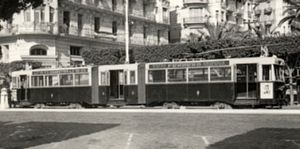 J.-L. La Rosa/Amtuir
|
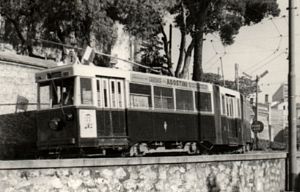 J.-L. La Rosa/Amtuir
|
|
|
|
The introduction of the articulated trams in Italy was also ment to decrease the number of the personell of the tram companies. The first batch of two-rooms-and-a-bath trams was constructed in Milan, the prototype from 1932 was soon followed by a series. Here a motorcar was coupled to a trailer, so the motors remained on the frontal axles. the articulated trams were fitted with the usual trolley-collectors on the frontal section, otherwise it would have been impossible to operate the switches in time. Although it would have been easier to raise the current collector if it would have been in the end, but in this case the frontal part would have overrun the switch before the collector cold have reached the regulating section of the pole.Italy
In the capitol Rome, in the years 1936-38 alltogether 50 motorcars and trailers were rebult as an articulated tram. The 19.8 meters long, 22.3 tons weight cars were fitted with 2x62 HP motors, in the frontal part within a C&T type underframe. This part was hauling a simpler trailer section with radial axes. The front of the cars were slightly modified. The reconstruction was done at the local company MATER, the electrical equippment was made at Compagnia Generale di Elettricita. Reportedly the maximum speed of the trams were around 30 km/h. These cars were in service until 1965, after some cars were ran by STEFER for a short time.
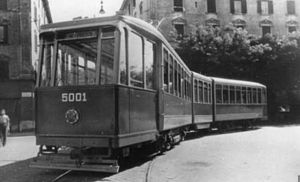 |
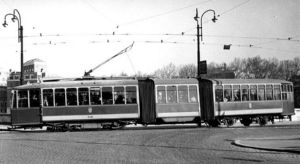 Tony Kozla/Collection
Don Ross
|
|
|
|
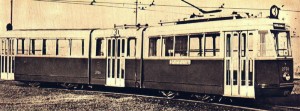 |
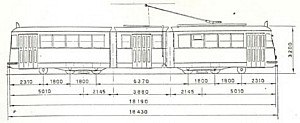 |
|
|
|
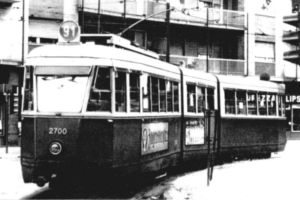 Collection István Papp
|
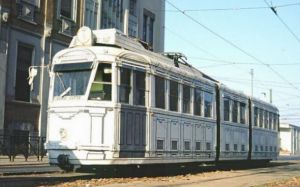 Stefano Paolini/Photorail
|
|
|
|
The sitting consuctor service and the guided flow of passangers was generally introduced in West-Germany in the '50s. Thus several cities' companies decided to create articulated trams from existing two-axle cars. The used cars could be "Aufbauwagen" (reconstructed old trams). "Kriegstraßenbahnwagen" (unity trams produced during the war) or "Verbundswagen"(made after the war); all had boxy shaped steel body and two axles in common. Naturally, the dimensions of the original trams limited the size of the doors and number of windows, sometimes severeal sub-variants of these types existed at the same company. In the '70s, often a second reconstruction followed the building of these articulated cars, when the one-man operation was introduced. On many cars, the original telescopic doors were replaced by automatic folding doors, and the electric control was again changed. The first of the two-rooms-and-a-bath cars were constructed around 1953-55 in Kassel, Dortmund and Hamburg, often the production of the following series were placed to another company (Credé, Hansa, DWM). Similar reconstructed vehicles ran in Duisburg too, with unidirectional and bidirectional subvariants. For the cities of Hamburg and Dortmund the cars were produced newly, built on the underframe of scrapped two-axle cars. These trams were not in service for a long time in Hamburg, because of their high weight and bad running attributes. However, during their operation time, they often were pulling a trailer.Articulated trams in the Federal Republic of Germany
Similar Credé trams were in service in Würzburg too.
Two unique articualted trams started their operation in Munich. After a DÜWAG articulated prototype was not found to be suitable for the tight curves of the network and the price of the tram was expensive, the local operator together with the company Rathgeber planned a two-rooms-and-a-bath type of tram on the basis of the M type solo cars, which were produced in high number at the time. The M type had however a three-axle construction, where the middle axle was steering the frontal and the rear one. So the articulated tram, that consisted of a two motored frontal part and a trailer rear part, had alltogether six axles with a floating middle section. This construction ran even in the curves of 12 meter radius without problem. The P1.65 type (later MG type) trams had an electropneumatic Kiepe controller to regulate 2x136 HP, which also made possible to form multiple units from these trams. Apparently they were designed for underground-tram operation, which was never built.
In the end, the intention of decreasing the number of conductors was not fulfilled, as the complicated fare-structure needed two conductors on each car. This is the reason, why a series was not following the two prototypes, instead the local company ordered three-axle motor+trailer M/m units, later the P/p series of "Kurzgelenkwagen" (four axle articulated trams). The two six-axle prototypes were scrapped in 1976.
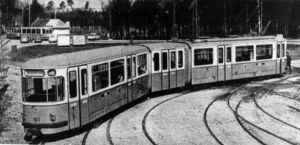 |
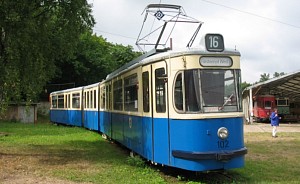 |
|
|
|
The city of Munich did not remain alone with the six-axle floating middle section trams. In 1959-61, Oberhausen was buying eight sush cars too. The first of them was made from two ex-Verbundswagen, the others were produced as new by Westwaggon. Five such cars were sold to Aachen in 1968, the others were scrapped in 1972. The length of these cars were 21,7 meters, with 4x71 HP motors.
The last time in West-Germany, the Esslingen Factory produced four-axle articulated trams with the reconstruction of the Stuttgart R700 type trams. The series of 35 new articulated cars were called DoT4, which were made in 1964-66. The 1000 mm gauge trams kept their particular streamlined frontal design of Esslingen. Because of the hills of the city, the trams were fitted with four motors (4x109 HP), becoming the most powerful tram of its time. Typically they were on the most gradient routes of Stuttgart, like on route 10, which was soon replaced by buses, later by the Stadbahn - but through tunnels.
The tramways of Germany are almost unexhaustable in vehicle construction, the trams with floating middle section were only one sub-type of the several articulated cars. It is not a surprise, that there existed two-room-and-a-bath type trailers too. Such cars were in service at the local railway Oberrheinische Eisenbahngesellschaft (OEG), which has several lines between Mannheim and Heidelberg. These trailers had eight axles, the frontal and rear section was standing on two bogies, similarly to the Düsseldorf and Boston constructions.
For the capitol Vienna the company Gräf & Stift produced articulated four axle cars in 1957, these trams become the type D. The unidirectional, three-doors trams were as slow and heavy as the Hungarian "Bengális". Thus by the year 1976, all of them were scrapped.Austria, Vienna
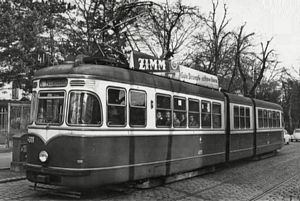 |
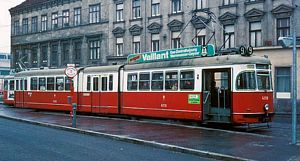 Tim Boric
|
|
|
|
There was also a prototype articulated tram in Switzerland, which however was not followed by a series. This tram was in service in Bern, woth the number 401.Bern
 |
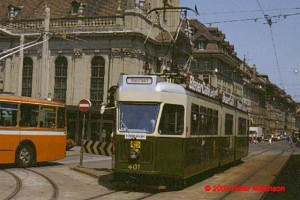 |
|
|
|
In Belgium, the transportation company of Brussels was started a reconstruction program in 1963-66, to produce articulated four-axle trams from the former "Standard" motorcars. The operator intended to decrease the cost of the new vehicles, this was the reason for the rebuildings, although at this time were the first articulated PCC's coming to service too. Alltogether 43 trams were made, with a four-motor construction, that were nicknamed "Caroline" by the personell. The total length of the cars were 21,133 meters, the total output of the motors were 4x92 HP. The trams were fitted with rheostatic and Westinghouse-type pneumatic brake.Brussels
The drivers and the passangers were not totally satisfied with these trams - it is likely, that the people were demanding the comfort of the competitor PCC's. The drivers has also some problems with the original trolley-poles: to raise the current collector the driver needed to use two ropes and some virtuosity. These trams remained in service until 1982-84.
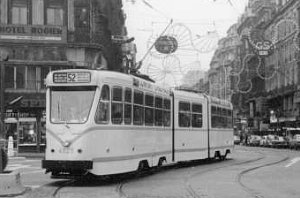 |
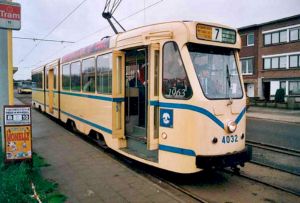 |
|
|
|
In East-Germany, after the request of Erfurt and Dresden, the Gotha Factory started to produce newly built four-axle articulated trams in 1957-58, using the construction of the previously built two-axle cars. The production of the series G4-61 began in 1961 (alltogether 119 vehicles), then after 1965 the building of series continued by the type G4-65 until 1967 (200 trams). A smaller batch from Gothaer articulated cars went to the Sowiet Union: they ran in Lvow, Saratov and Tallin. The majority was put in service in the GDR: some were in Dresden and Magdeburg; but there were more in use in Erfurt, Gotha, Leipzig, Potsdam and Rostock. After exchanging of cars between the operators, some went also to Nordhausen.The articulated Gothaer tramcars of the German Democratic Republic
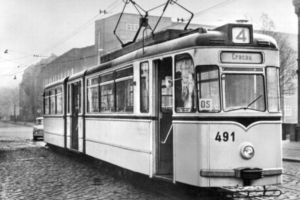 Collection István Papp
|
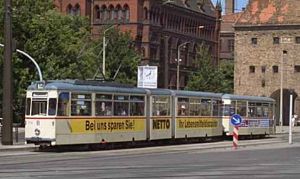 |
|
|
|
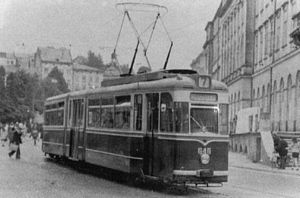 Hans Lehnhart
|
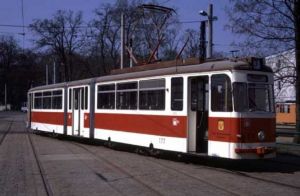 Christoph Heuer/Gothawagen
|
|
|
|
For the city of Katowice, there was ten articulated trams supplied by the Chorzów-factory, as a reconstruction of ex-german wartime trams.Poland
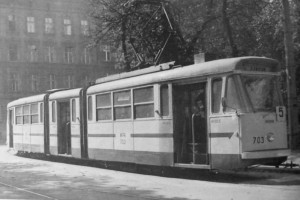 Hans Lehnhart
|
|
|
Amongst the operators of Sowiet Union, I know only two, which had self-built four-axle articulated trams in service. One of them was in Riga, from 1947. The other was Tbilisi in the Kaukasus. Four such trams were constructed, probably in 1959-60. They were not long in service, until only the end of 1960.Sowiet Union
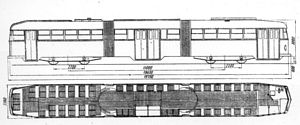 |
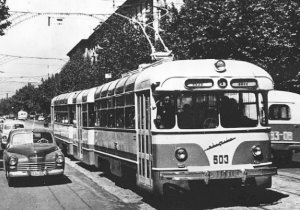 Coll. Uszty-Ktavszkij Factory/Photo.Tramwaj.ru
|
|
|
|
Remarkably, some of these problems were seized to exist, when the cars had a four-motor construction, like the example of Alger or Stuttgart (though their suspension was also not as good as the cars on bogies). The use of the four motor construction was however not very common, as it needed to modify the usual direct coupling of two motors, which required to change the controller.
Today (2004) the only place to find such trams in regular passanger service is Hungary*. Previously in 1996 the city of Rostock scrapped their last Gothaer articulated tram, and the city of Gorzów also pulled out of service the four-axle ex-Kassel cars. At some places, these trams are used as sightseeing cars (Erfurt, Stuttgart, Torino), and several of these trams became the part of museums' collections. In the towns of Miskolc (north-east-), Debrecen (east-) and Szeged (south-east Hungary) the "Bengális" are still in service, though this year Miskolc will pull out all of service except two reserve cars, and Szeged also launched a program to replace them in the following years. In Debrecen, the vehicles are generally in a better condition then the average, thus the replacement of these cars is not likely soon.
Finally, although the two-rooms-and-a-bath cars are disappearing, the principle of floating middle sections is still alive. Hundreds of low-floor trams were produced in the last decade, which consisted of the combination of floating and axled sections. Such trams are the most commonly sold 100 % low-floor types by the three great multinational companies: the Siemens Combino (and its predessors), the Alstom Citadis and the Bombardier Incentro and Flexity Outlook, but even the type Variobahn, the Fiat Cityway, the Ansaldo Sirio and the Skoda Astra, Vektra types have all similar construction. However almost all of them have already substantially different construction of the articulation, as the ratio of the length of the floating and the axled sections changed: nowdays the floating sections are long, and the four-wheeled parts are short. In the year of 2004, because of a constructional fault, the production of Combinos were stopped (which was previously the most commonly sold type), but it is still likely, that the majority of the future 100% low-floor trams will be similar constructions because they are relatively simple and cheap, although the running properties of these trams are still not as good as the ones with proper bogies.
* - I'm afraid, I need to revise this sentence. >> Continue! >>
I used several webpages found on the internet to collect photos and data. Any comment is welcomed.
|
|
||
|
|
|
|
2004.07.